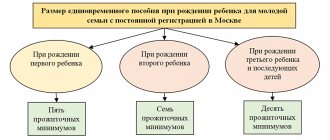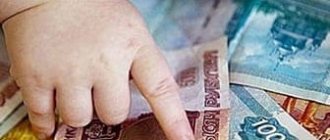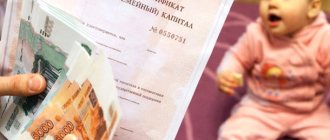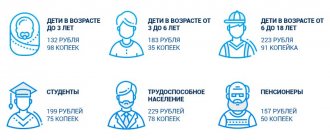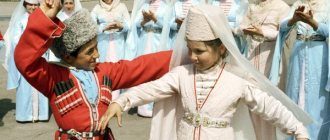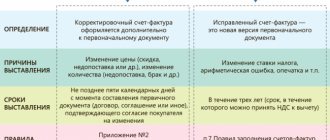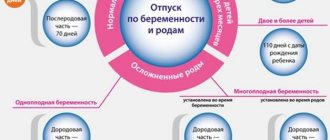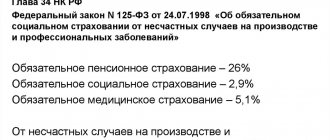From January 1, 2021, the minimum wage has been increased to 11,280 rubles. In this regard, there have been changes in the calculation of some “children’s” benefits. How to calculate “children’s” benefits from January 1, 2021? What is the amount of benefits from January 1, 2021? Has the minimum amount of child care benefit changed? How much will the Social Insurance Fund reimburse for “children’s” benefits? What are the amounts of new child benefits for the first and second child in different regions of Russia and who is entitled to such benefits? You will find answers to these and other questions related to children's benefits, as well as a table with new sizes in this article.
Types of child benefits
“Children’s” benefits usually include payments related to the birth of children. The list of such payments is contained in Federal Law No. 81-FZ of May 19, 1995 “On State Benefits for Citizens with Children” (hereinafter referred to as Law No. 81-FZ). Most often, employers have to deal with the calculation and payment of the following types of “children’s” benefits:
- benefits for registration in the early stages of pregnancy;
- lump sum benefit for the birth of a child;
- monthly allowance for child care up to 1.5 years;
- maternity benefit.
The listed types of benefits are paid by the employer to its employees. In this case, with the social benefits paid, you can reduce insurance contributions to the Social Insurance Fund or receive the necessary compensation from the fund.
It is worth noting that in some regions there is a pilot project in which benefits are paid not by employers, but directly from the Social Insurance Fund. The territorial bodies of the Social Insurance Fund in the “pilot” regions themselves calculate and pay “children’s” benefits. Since January 1, 2019, there have been more .
Also see “ Sickness benefit amount from 2021: new amount “.
Support size
Let's look at the amounts.
| Category of citizens | Benefit amount |
| Benefits for women during pregnancy and childbirth | |
| Employed | Average daily earnings for the entire vacation in BiR |
| Minimum for workers |
|
| Maximum for workers |
|
| Unemployed people laid off due to liquidation of an enterprise (at the rate of 1 month) | 655,49 |
| Full-time students | In the amount of scholarship |
| Women soldiers | In the amount of the current salary |
| Registration in early pregnancy | 655,49 |
| Pregnant wives of conscripts | 27680,97 |
| At the birth of a child | 17479,73 |
| Upon adoption | 17479.73 or 133559.36 |
| Maternal capital | 466617 |
| Monthly benefits | |
| Caring for a baby up to 1.5 years old for a working mother | 40% of average earnings for the previous 2 years |
| Minimum up to 1.5 years for working mothers |
|
| Up to 1.5 years for unemployed women and those whose work experience is less than six months |
|
| "Putin" payments | Children's living wage |
| Caring for a military child | 11863,27 |
| For the loss of a breadwinner-soldier | 2386,02 |
| Payments for children from the Chernobyl zone |
|
| Payments for the third child under 3 years old | Children's living wage |
| Children under 18 years of age from low-income families | Set regionally |
Read also: Alimony if the husband does not officially work
Other types of lump sum payments
There are other types of family support after the arrival of a new Russian citizen.
Maternal capital
The amount of maternity capital in 2021 is 466,617 rubles. There are no changes planned in the area of state benefits or the introduction of additional measures of social support for families after the birth of a newborn in 2021.
"Presidential" payments
In 2021, “presidential” subsidies established last year on the initiative of Vladimir Putin will continue to operate.
People began to call them “Putin’s”. This support measure is provided if the first or second baby is born (adopted). You can receive benefits until the child turns 3 years old. There are other conditions that confirm compliance with the criteria of need. The income (average per capita) of the applicant's family (for able-bodied citizens) should not exceed an amount equal to 2 subsistence minimums (ML) of a specific constituent entity of the Russian Federation. The benefit corresponds to the volume of regional children's PM: from 8291 rubles. in the Belgorod region up to 22,730 rubles. in the Chukotka Autonomous Okrug.
Regional benefits
In addition to federal support, Russia provides for regional protection measures (so-called “gubernatorial” assistance). The grounds for provision and amounts of payments are established by legal acts of local authorities.
Good to know! The size and types of regional subsidies directly depend on the economic state of a particular constituent entity of the Russian Federation and the capabilities of the local budget, and therefore sometimes differ significantly.
"Luzhkovskaya" help
To support young families in Moscow, so-called “Luzhkov” subsidies are paid. They are valid for one of the parents (adoptive parents) under 30 years of age. The family must meet the following requirements:
- both parents have permanent residence in the capital;
- the applicant lives permanently in Moscow and is registered in the city along with the child; in this case, the second parent may be registered in another city;
- single mother, resident of the capital;
- the only adoptive parent registered in Moscow along with the child.
Size is:
- for the first child - 5 PM established in Moscow in the current quarter;
- at the birth of the second baby - 7 PM;
- starting from the third - 10 reps.
"Gromovsky" payments in the Moscow region
Residents of the Moscow region also receive additional social support for the birth (adoption) of children: “Gromov” payments (named after the governor who signed the regional law).
This is a whole list:
- one-time PRR;
- monthly allowance for a newborn until he reaches 16-18 years of age;
- regional maternity capital;
- cash compensation for needy categories of families.
In the northern capital
In St. Petersburg, at the birth of a child and for children under 7 years of age, special additional assistance is paid using special children's cards. The money is intended only for non-cash payments - for children's goods and products from specialized stores.
Indexation of child benefits in 2019
There has been no indexation of “children’s” benefits since January 1, 2021. After all, child benefits are indexed annually from February 1. The indexation coefficient is approved by the Government of the Russian Federation (Federal Law dated December 19, 2016 No. 444-FZ.) Indexation concerns the following benefits paid by the employer:
- a one-time benefit for women who registered in the early stages of pregnancy;
- lump sum benefit for the birth of a child;
- monthly child care allowance.
From January 1 to February 1, 2021, “children’s” benefits should be paid in the same amounts as in 2021. Here are the amounts of “children’s” benefits in the table until February 1, 2021.
| Type of benefit | Until February 1, 2021 |
| At the birth (adoption) of a child | RUR 16,759.09 |
| For registration in the early stages of pregnancy | RUB 628.47 |
| Minimum care for a second or younger child up to one and a half years old | 6284.65 rub. |
However, from February 1, 2021, the indexation coefficient for child benefits is 1.043.
Taking into account the new coefficient, from February 1, 2021, “children’s” benefits should be paid in indexed amounts, which are shown in the table below.
| Type of benefit | From February 1, 2021 |
| At the birth (adoption) of a child | RUB 17,479.73 (16,759.09 x 1.043) |
| For registration in the early stages of pregnancy | RUB 655.49 (628.47 x 1.043) |
| Minimum care for a second or younger child up to one and a half years old | 6554.89 rub. (6284.65 x 1.043) |
In districts and localities where regional wage coefficients have been established, “children’s” benefits (both in January 2021 and from February 1, 2021) will be higher, since they need to be additionally increased by the amount of the increasing coefficient (Article 5 of Law No. 81-FZ). Next, we will comment on the conditions and procedure for indexing benefits from February 1, 2021.
Types of payments
Categories of government subsidies, the procedure for assigning them and the conditions for their provision are established at the federal level. Material support is one-time or monthly.
One-time payments
One-time subsidies related to pregnancy and the birth of a young Russian are a category of one-time material state support.
The expectant mother can receive some subsidies during pregnancy, before the baby is born. Read also: Maternity capital for buying a car
PI&R (“maternity benefits”) belongs to the category of insurance protection measures, provided at the expense of the Social Insurance Fund. Money is paid in total for the entire vacation. Unlike PRR, only women have the right to count on PB&R:
- working;
- unemployed or who lost her job during the liquidation of an enterprise during the calendar year before receiving unemployed status;
- full-time student;
- contract military personnel;
- who has adopted a child (and corresponds to the listed groups).
It is important to know! If a mother is paid child care benefits at the time of calculating PB&R, she has the right to receive only one of them - at her choice.
In 2021, PB&R is paid only for vacation days of the same name. In other words, if a woman does not take advantage of the right to the required leave, continues to work and receive a salary, then she will not be paid benefits. An organization should not provide a woman with two categories of payments at the same time.
They receive money at their place of work or service. Other categories are available from local social security offices. If a woman has worked part-time in the same organizations for the previous 2 years, then payments are made by both employers.
Child Birth Benefit (BCB)
This is a one-time payment assigned to one of the parents.
It has a similar size and does not depend on the order of birth of the babies or the fact of employment. An application for a PRR must be submitted within six months of the baby’s birth. The amount of the benefit, taking into account the inflation factor of 1.043, from February 2021 amounted to 17,479.73 rubles. A family that has adopted a little Russian can count on the same amount. If a disabled child, children over 7 years old, or several relatives at the same time are taken into care, the payment will be 133,559.36 rubles.
Working northerners are entitled to an increased subsidy, multiplied by the regional coefficient. The conscript's wife will receive 27,680.97 rubles. When two or more children appear, the PRR relies on each one. If the baby is stillborn, no benefits are paid.
The PRP is assigned and paid by the employer no later than ten days from the date of submission of the package of documents. Social security authorities make payments to unemployed and full-time students no later than the 26th day of the month following the month in which the documentation was submitted.
If in a family with one non-working spouse, the second one works, then the PRR will be assigned to the working one.
Benefit for registration in early pregnancy
This benefit is supposed to be paid once (that is, in a lump sum). Women who:
- registered in medical institutions before 12 weeks of pregnancy;
- have the right to maternity benefits (Article 9 of Law No. 81-FZ).
This benefit will be paid in a new amount from February 1, 2021 - 655.49 rubles. rubles However, a controversial situation is possible.
Let's give an example.
The employee goes on maternity leave from February 4, 2019. On January 25, 2021, the woman submitted to the accounting department a certificate from the antenatal clinic stating that in 2021 she registered in the early stages of pregnancy (up to 12 weeks). How much benefits should I pay for early registration?
The benefit for registration in the early stages of pregnancy should be paid in addition to the maternity benefit (Article 9 of Law No. 81-FZ). Therefore, the benefit for registration in the early stages of pregnancy must be transferred in the amount that is established on the start date of maternity leave.
In our case, the woman went on maternity leave on February 4, 2021. Therefore, the registration allowance should be paid in the amount of 655.49 rubles (including indexation by a factor of 1.043). If the start of maternity leave was in January 2021, then the benefit would be in a smaller amount - 628.47 rubles.
Maternal capital
Families with a second and subsequent child have received a maternity capital certificate since 2007. Postnatal benefits are issued upon application to the Pension Fund of the Russian Federation at the place of residence.
The amount of federal support is 453,026 rubles.
Legally permitted use of funds:
- Receiving a monthly payment for a child up to 1.5 years of age.
- Formation of a mother's funded pension.
- Repaying a mortgage loan.
- Children's education.
- Adaptation of a disabled child.
Initially, the privilege of receiving the certificate belongs to the mother. In the event of deprivation of her parental rights or death, maternity capital is due to the father or the minor himself, if the permissible period for issuing the certificate has expired.
Guardianship does not allow for this type of government support.
Regional
Each subject independently determines measures of social support for families with children. All regions except Moscow, Crimea and the Stavropol Territory have their own regional capital programs. The source of funding is the subject’s budget, therefore the amount of support and the conditions for allocation vary:
- Moscow region. 100 thousand rubles at the birth of a second child. The funds can be used for education or improving living conditions.
- In Chuvashia, 300 thousand rubles are allocated. upon adoption. The intended use of funds is health improvement, treatment, education, housing.
- Yaroslavl region. RUB 56,606 Upon the birth of a third child and staying on the territory of the subject for at least one and a half years. The funds can be spent on any family need.
One-time benefit for the birth of a child from February 1, 2021
One of the parents has the right to a lump sum benefit upon the birth of a child. If two or more children were born, then the benefit is paid for each of them (Article 11 of Law No. 81-FZ).
The employer must pay the benefit within six months after the birth of the child if the employee has submitted the documents necessary to assign the benefit (Article 17.2 of Law No. 81-FZ). Due to the indexation of benefits from February 1, 2021, an ambiguous situation may arise when assigning.
The child was born in 2021, and the woman came to the accounting department in February 2019 to receive a one-time benefit for the birth of a child. How much benefits should I pay?
The amount of a lump sum benefit for the birth of a child should be calculated on the date of birth, and not on the date of application for benefits (FSS letter dated January 17, 2006 No. 02-18/07-337). In our case, the child was born in 2018, so the benefit amount will be 16,759.09. (excluding indexation by a factor of 1.043). Pay a one-time benefit for the birth of a child in the indexed amount (RUB 17,479.73) if the child is born from February 1, 2019.
Receipt procedure
The appointment of a PRR is of a declarative nature and requires the mandatory submission of an appropriate application with a package of necessary documents, determined by the category of parents.
Range of benefit recipients
A prerequisite for receipt is the very fact of the birth of the child.
The applicant may be one of the parents. Read also: Ban on a child traveling abroad
Funding sources define three categories of recipients:
- At the expense of the Social Insurance Fund - employed persons;
- At the expense of federal subsidies - full-time students, unemployed and unemployed, pensioners;
- At the expense of the federal budget - contract military personnel, employees of the Ministry of Internal Affairs, customs officers, firefighters.
Who can receive benefits?
According to federal law, the right to a one-time subsidy upon the birth of a newborn has one of the parents or a person replacing him (guardian, adoptive parent or foster parent).
What documents are needed to process the payment?
The specific list of documents depends on the category of the applicant. General required documents include:
- passport;
- application for payment of benefits for the birth of a child indicating personal data;
- certificate from the registry office about the birth of the baby (F 24);
Certificate form F24 - a certificate of non-receipt of a one-time PRP from work (service) or the social security department at the place of registration of the husband (if the father is applying for payment, a similar certificate from the mother is needed).
Sample certificate of non-receipt of a one-time benefit
The additional package includes the following documents:
- for the unemployed - an extract from the work book or other document confirming the last place of employment or study;
- for divorced applicants - a certificate from the housing organization confirming the cohabitation of the applicant with the newborn, a certificate of divorce;
- for non-workers - a certificate of non-assignment of support by social protection authorities at the place of registration.
Advice! The package of documents includes a certificate of non-receipt of benefits by the other parent. In the event of a tense relationship (especially in the case of divorce), if the young father suddenly refuses to provide such a certificate, the woman can solve the problem on her own by contacting her husband’s employer with an official letter containing a request for the document.
Procedural Features
The following parents are excluded from the category of PRP recipients:
- deprived of rights;
- those who moved for permanent residence to another state;
- whose children are transferred to state support.
The payment is not accrued to a non-working parent if the second one is employed (serves), to the father of a child born out of wedlock, to a parent after a divorce if the child remained with the other parent.
Monthly childcare benefit for children up to 1.5 years old from February 1, 2021
Also see “ Child Care Benefit 2021 “.
Minimum amount of care allowance
The minimum amount of benefits for caring for the first child up to one and a half years old depends on the minimum wage (Part 1.1, Article 14 of the Federal Law of December 29, 2006 No. 255-FZ). Since from January 1, 2021, the minimum wage is 11,280 rubles, the minimum amount of benefits for caring for the first child is 4,512 rubles. (RUB 11,280 x 40%). For more information about this, see “ Table with new amounts of child care benefits in 2019. ”
The “minimum wage” for caring for the second and subsequent children has not changed since January 1, 2019. It remained 6284.65 rubles even after January 1, 2021.
From February 1, 2021, the benefit indexation coefficient was approved in the amount of 1.043. Therefore, from February 1, the allowance for the second and subsequent children is 6554.89 rubles. (6284.65 x 1.043).
Maximum amount of care allowance
In 2019, the maximum amount of child care benefits for children up to 1.5 years is not limited. However, the amount of average daily earnings from which the benefit is calculated is limited.
The amount of average daily earnings for calculating benefits cannot exceed the sum of the maximum values of the base for calculating insurance premiums for the two years preceding the year of parental leave, divided by 730 (Part 3.3 of Article 14 of the Federal Law of December 29, 2006 No. 255- Federal Law). Therefore, in order to determine the maximum amount of average daily earnings, the following formula is used:
Maximum average daily earnings = Sum of the maximum values of the base for calculating insurance contributions to the Social Insurance Fund for the two previous years / 730
It turns out that if an employee’s vacation begins in 2021, it is necessary to take into account the values of the maximum values of the base for calculating contributions to the Social Insurance Fund for 2021 and 2021. They are:
- in 2021 – RUB 755,000;
- in 2021 – RUB 815,000.
Therefore, in 2021, the maximum average earnings for calculating care leave will be RUB 2,150.69. ((RUB 755,000 + RUB 815,000) ÷ 730 days).
Next, we need to multiply the average daily earnings by the average monthly number of calendar days equal to 30.4 (Part 5.1, Article 14 of Law No. 255-FZ). Total: in 2021, the maximum average monthly earnings for calculating benefits will be 65,380.82 rubles. (RUB 2,150.69 × 30.4).
The amount of the monthly childcare benefit for a child up to 1.5 years old is generally equal to 40% of the average monthly earnings (Part 1, Article 15 of Law No. 81-FZ). Therefore, in 2021, the maximum amount of monthly benefit per child is RUB 26,152.33. (RUB 65,380.82 × 40%). This is the amount that must be reimbursed from the Social Insurance Fund.
If there are several children
Benefits for the birth of a second child in 2021 differ from payments assigned for the first-born in that it is possible to register maternity capital (its amount remains the same - 453,026 rubles).
Benefits for the birth of a third child in 2021 may be supplemented by regional material additional payments (regional maternity capital or material assistance), the decision on the need for which is made by the authorities of the constituent entities of the Russian Federation.
What will be the benefits for the birth of twins in 2021:
- according to BiR, payment is subject to not 140 days, but 194 (maternity leave from the 28th week of pregnancy);
- a one-time benefit for the birth of a child in 2021 is assigned to each newborn;
- For each of the twins, an amount of payment in connection with care is assigned for up to 1.5 years.
Law No. 418-FZ dated December 28, 2017 introduces additional support for families experiencing financial difficulties. The category of those in need includes families whose monthly income per person is below the subsistence level (in relation to the standard of an able-bodied citizen), multiplied by a factor of 1.5. The benefit is paid every month (up to the child’s age of one and a half years), its value is equal to the “children’s” subsistence minimum approved in a particular region. If we are talking about the birth of a second child, then financing is made from maternity capital.
Maternity benefit in 2019
The table below shows the minimum and maximum amounts of maternity benefits. They are valid from January 1, 2021. They were not affected by the February indexation.
| Maternity benefit (M&B) | Amount, rubles |
| For working women (general calculation procedure) | Average daily earnings for all days of vacation according to BiR (140, 156 or 194 days) |
| Minimum payment for employed women |
|
| Maximum benefit for working women |
|
Read also
28.10.2018
Payments for the first child in 2020-2021: complete list
What payments are due to parents at the birth of their first child?
This issue requires special consideration, since in 2021 there have been changes to the list of such payments. So, what payments do you receive at the birth of your first child this year? What is their complete set and who can receive it to the maximum extent?
Benefits for the first child in 2020-2021 are divided into two groups:
- that took place before 2021 and continue to be applied while maintaining the principles of their purpose;
- introduced from 2021.
Payments included in the first group are regulated by the Law “On State Benefits...” dated May 19, 1995 No. 81-FZ. These payments include:
- amounts paid in connection with pregnancy and childbirth;
- one-time payment on the occasion of birth;
- benefits provided to persons caring for a child in the first years of his life.
The second group consists of payments for the first child, which were not previously used in Russia. Their introduction (Law “On Monthly Payments...” dated December 28, 2017 No. 418-FZ) was due to the intention of stimulating the birth of children in families who do not dare to take this step due to insufficient income. That is, such payments will not be accessible to everyone, and this is their basic difference from payments of the first group, the right to which is always available to persons subject to social insurance, and in some cases also arises for the uninsured.
Monthly payments - 2020-2021 for the first child: who is entitled to and at what expense
The rules introduced by Law No. 418-FZ establish the possibility of additionally receiving child benefits from 2021 - both for the first and for the second - in the form of monthly payments until the child reaches 3 years of age. However, not everyone can use this opportunity. However, the rules for assigning benefits to the first and second children differ.
The mother or father of the child, as well as the person who replaced them (adoptive parent or guardian), are entitled to apply for benefits for the first child in 2020-2021.
It becomes available if:
- a person permanently residing in Russia applied for him;
- the child was born after 2021 and is registered as a citizen of the Russian Federation;
- the per capita income of the family in which the child was born is a value that does not reach the value of 2 times the subsistence level of the population capable of working, established in the constituent entity of the Russian Federation for the second quarter of the year preceding the year of application for payment;
- the appeal occurred no later than the child reaching the age of one and a half years;
- the child is not fully supported by the state.
The amount of payment by Law No. 418-FZ is defined as the minimum subsistence level established in a constituent entity of the Russian Federation for children for the second quarter of the year preceding the year of application for benefits.
Thus, to determine the amount of benefit for the first child in 2020-2021, two values of the cost of living, determined quarterly in the region, have a special role:
- for the population capable of working;
- for children.
When calculating income per capita of a family (it is determined for the 12 months preceding the month of application for benefits, by dividing the total amount of income by 12 and by the number of members in the family, excluding persons on state support), the following are used:
- remuneration for labor;
- pensions, benefits, scholarships:
- payments received by legal successors;
- payments for the performance of government duties;
- monetary allowances for people employed in the service.
Payment for the first child in 2020-2021 should be made by regions (municipalities), but at the expense of targeted revenues from the federal budget. You should apply for it to the social security authorities in person or through the MFC by submitting an application. It is not necessary to attach the necessary supporting documents from among those that can be obtained by the body making the decision on payment in the manner of interdepartmental interaction. However, some documents will form attachments that are required for the application to be accepted. Their complete list is contained in Appendix No. 2 to the order of the Ministry of Labor of Russia dated December 29, 2017 No. 889n.
One application will be valid for one year. To continue receiving benefits, you must apply again.
Read more about Putin's payments here.
The amount of benefit for the first child from the moment of introduction and for 2020-2021
Due to the established rules for determining the specific amount of payment for the first child in 2020-2021, it will vary by region. Accordingly, when you change region, the amount of the benefit will also change. The recipient of the payment will have to independently notify the social security authority of the change of residence within a month from this event. Changes in other grounds giving the right to receive benefits also oblige him to take similar actions.
Payments are made in full (from the date of birth) if the application for benefits occurs no later than six months from the date of birth. If the six-month period is exceeded, then the period from the moment of application until the child turns one and a half years old will be paid. Upon reaching this age, the benefit payment automatically stops (from the day following this event). Other grounds for termination of payment are:
- moving to another region;
- refusal to receive;
- death of a child;
- death of the recipient, his unknown absence or deprivation of parental rights.
Payments in these cases will stop from the month following the month of notification of change of residence (refusal to receive) or the month of death (entry into force of the court decision). In situations of refusal to receive and cancellation of a decision made by the court, payment may be resumed.
